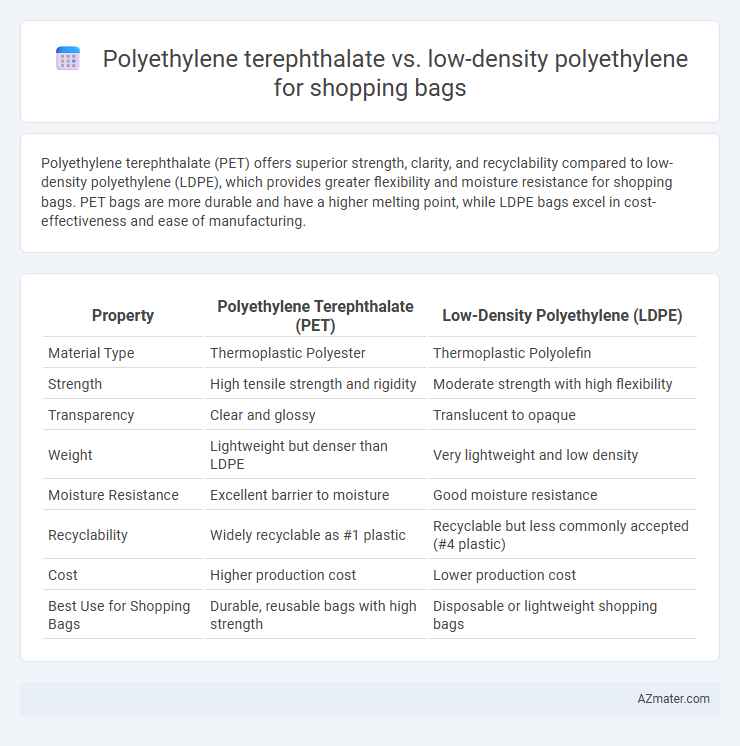Polyethylene terephthalate (PET) offers superior strength, clarity, and recyclability compared to low-density polyethylene (LDPE), which provides greater flexibility and moisture resistance for shopping bags. PET bags are more durable and have a higher melting point, while LDPE bags excel in cost-effectiveness and ease of manufacturing.
Table of Comparison
| Property | Polyethylene Terephthalate (PET) | Low-Density Polyethylene (LDPE) |
|---|---|---|
| Material Type | Thermoplastic Polyester | Thermoplastic Polyolefin |
| Strength | High tensile strength and rigidity | Moderate strength with high flexibility |
| Transparency | Clear and glossy | Translucent to opaque |
| Weight | Lightweight but denser than LDPE | Very lightweight and low density |
| Moisture Resistance | Excellent barrier to moisture | Good moisture resistance |
| Recyclability | Widely recyclable as #1 plastic | Recyclable but less commonly accepted (#4 plastic) |
| Cost | Higher production cost | Lower production cost |
| Best Use for Shopping Bags | Durable, reusable bags with high strength | Disposable or lightweight shopping bags |
Introduction to Polyethylene Terephthalate (PET) and Low-Density Polyethylene (LDPE)
Polyethylene terephthalate (PET) is a strong, lightweight polyester widely used in packaging and shopping bags due to its excellent durability and resistance to moisture and chemicals. Low-density polyethylene (LDPE) is a flexible, soft thermoplastic known for its high ductility and impact resistance, making it a common choice for plastic bags that require stretch and tear resistance. While PET offers superior structural strength and recyclability, LDPE provides enhanced flexibility and ease of production, influencing their application in different types of shopping bags.
Chemical Structure and Physical Properties Comparison
Polyethylene terephthalate (PET) is a polyester with a rigid aromatic backbone derived from terephthalic acid and ethylene glycol, resulting in a strong, crystal-clear material with high tensile strength and thermal resistance. Low-density polyethylene (LDPE) consists of branched chains of ethylene monomers, producing a flexible, low-crystallinity polymer characterized by a lower melting point, high impact resistance, and excellent elongation. PET's structured rigidity and chemical resistance make it suitable for durable, reusable shopping bags, while LDPE's flexibility and moisture resistance favor single-use, lightweight plastic bags.
Manufacturing Processes of PET vs LDPE Shopping Bags
Polyethylene terephthalate (PET) shopping bags are typically manufactured through an injection molding or film extrusion process, resulting in a rigid and durable structure with high tensile strength and chemical resistance. Low-density polyethylene (LDPE) shopping bags are produced using blown film extrusion, creating flexible, lightweight, and stretchable bags with excellent impact resistance. The manufacturing of PET bags involves polymerization and melting of terephthalic acid and ethylene glycol, while LDPE bags are made by polymerizing ethylene at low pressure, impacting their physical properties and end-use performance.
Durability and Strength Analysis
Polyethylene terephthalate (PET) offers superior tensile strength and abrasion resistance compared to low-density polyethylene (LDPE), making PET shopping bags more durable under heavy loads and repeated use. LDPE provides greater flexibility and impact resistance but has lower puncture resistance and tensile strength, which can lead to quicker wear and tearing under stress. The enhanced crystallinity and molecular orientation in PET contribute to its higher durability and strength, suitable for long-term reuse and heavier shopping items.
Environmental Impact and Recyclability
Polyethylene terephthalate (PET) offers higher recyclability rates and is commonly processed through established recycling systems, reducing environmental impact compared to low-density polyethylene (LDPE). LDPE, while flexible and lightweight for shopping bags, presents challenges in recycling due to its lower melting point and tendency to contaminate recycling streams. PET's ability to be repurposed into fibers and containers enhances its sustainability profile relative to LDPE's limited recycling infrastructure and higher potential for environmental pollution.
Cost Efficiency and Market Availability
Polyethylene terephthalate (PET) offers higher cost efficiency than low-density polyethylene (LDPE) in applications like shopping bags due to its durability and recyclability, reducing long-term expenses. LDPE remains more widely available in the market, benefiting from lower upfront costs and established manufacturing processes. PET shopping bags provide better strength-to-weight ratios, making them more economically viable over multiple uses despite typically higher initial material costs.
Weight Capacity and Practical Performance
Polyethylene terephthalate (PET) shopping bags offer higher weight capacity due to their superior tensile strength and durability compared to low-density polyethylene (LDPE) bags, which are more prone to stretching and tearing under heavy loads. PET's structural integrity makes it ideal for carrying heavier groceries and bulkier items, enhancing practical performance in everyday use. LDPE bags, while lighter and more flexible, are better suited for lighter, less demanding tasks, making them less reliable for repeated or heavy-duty shopping needs.
Consumer Preferences and Usability
Polyethylene terephthalate (PET) offers superior strength, durability, and clarity compared to low-density polyethylene (LDPE), making PET shopping bags more appealing to consumers seeking reusable and visually attractive options. LDPE bags provide greater flexibility and softness, enhancing usability for light, everyday purchases, but their lower tensile strength limits reuse and load capacity. Consumer preferences often favor PET for eco-friendly and long-term use, while LDPE remains popular for convenience and cost-effectiveness in disposable shopping bags.
Regulatory Standards and Compliance
Polyethylene terephthalate (PET) and low-density polyethylene (LDPE) both must comply with stringent regulatory standards such as FDA, EFSA, and REACH for food contact safety and environmental impact in shopping bag applications. PET generally meets higher standards for recyclability and chemical resistance, facilitating compliance with circular economy directives and reducing toxic leachates. LDPE excels in flexibility and biodegradability certifications yet often faces scrutiny in single-use plastic bans and waste management regulations due to lower recycling rates.
Future Trends in Shopping Bag Materials
Polyethylene terephthalate (PET) offers enhanced durability and recyclability compared to low-density polyethylene (LDPE), making it a strong contender in the evolution of shopping bag materials. Innovations in biodegradable PET and bio-based LDPE are driving future trends toward environmentally sustainable packaging solutions. Market projections indicate a growing shift favoring multi-use PET bags due to increasing regulatory pressures and consumer demand for eco-friendly products.

Infographic: Polyethylene terephthalate vs Low-density polyethylene for Shopping Bag
 azmater.com
azmater.com